
Walking and running are inherent gifts of humans, as well as the most common physical activities and integral parts of their daily life after they learn how to walk. Therefore, they are also activities most acceptable to humans without need for special learning, in addition to being action modes most compliant with human physical structure. However, along with the progress of human civilization, people have gradually turned away from the most natural exercises, excluding walking and running from the list of specific activities in their daily life. In order to overcome the confinement of time and space, allowing people to resume the exercises of their inherent gifts, treadmills were invented. Up to now, treadmills are still favorites in the sports equipment market. In the development history of exercise devices, elliptical cross trainers are without doubt a major breakthrough, changing the direction of the fitness equipment market. The design concept of treadmills is to transplant the behavioral mode of humans on the ground to machines, substituting moving belt for fixed ground, so as to remove the confinement of space, a kind of instinct design. Although with the design concept also deriving from walking and running, elliptical cross trainers emulate human proceeding patterns in mechanical structure, so that humans can assume the appearance of walking or running without actually doing the exercises, which is a major difference from treadmills.
Compared with other fitness equipment for enhancing cardio-respiratory endurance, the product range of elliptical trainers is rather wide. Despite some evolutionary changes, basic types of most other products are fixed. Since its invention, elliptical cross trainers have been undergoing constant changes in its structural appearances. As its design concept aims only to emulate appearances of human bodies in exercises, rather than building up a semi-real exercising environment, any structure capable of producing emulated exercising routes will meet the requirements of the product, greatly cutting the restrictions on its development. Exercise of elliptical cross trainers is one of both legs making continuous forward and backward movements on an elliptical route, featuring uninterrupted cyclic movements, which are often achieved via guidance of cranks in mechanical structure. Therefore, crank is the core structure of an elliptical cross trainer. Meanwhile, as elliptical cross trainers operate on foot pedaling, the amount of exercise hinges on the resistance to pedaling, leading to the installation of resistance system. Due to considerations of simplicity and cost saving in mechanical design, there is often an integrated design for crank and resistance system, which, as a result, are often adjacent or close to each other. Consequently, from the position of crank, one can tell the whereabouts of resistance and transmission systems. With the position of pedals as reference, crank is positioned either in the front or the back. Under similar conditions, the position of crank, in the front of back, will affect somewhat route shape and pedal angle, but not the size of route.
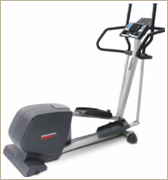 |
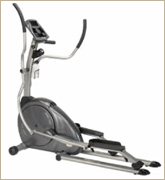 |
In addition to crank's position, another focus of attention is elliptical cross trainers' pedals. Pedals are the structure guiding feet to exercise along in elliptical route, as well as determining angles of ankles, and are mostly fixed to movable levers creating elliptical routes. According to different structural designs of elliptical cross trainers, pedals sometimes have to operate in sync with gliding, floating, or other mechanisms, to achieve necessary functions or to boost comfort for users. Pedals of some kinds of elliptical cross trainers are positioned at the end of movable levers, in a state of suspension, cutting down space occupied by the machines and somewhat broadening the range of pedal angles. |
| Figure 2 Model With Back Crank ( ProForm 835 ) |
Figure 1 Model With Front Crank (Horizon Andes 101) |
Figure 5 Suspending Pedals
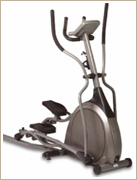 |
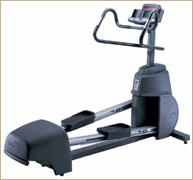 |
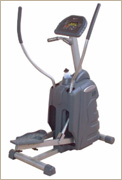 |
| VISION X6200HRT |
Star_Trac NaturalRunner |
Steelflex XE3700 |
Most elliptical cross trainers are furnished with synchronized handlebars, enabling upper and lower limbs to exercise simultaneously, which are also often coupled with a set of small fixed handlebars or large fixed handlebars for some models.
Figure 9 Elliptical Cross Trainers with Different Mechanical Structures
In practice, crank-slider elliptical cross trainers use rollers and tracks to substitute for slider. Most of such elliptical cross trainers feature design of front cranks, but with some exceptions when the adjustment of the tracks is needed. In order to add more changes to exercises, some elliptical cross trainers have tracks placed in the front, in emulation of slope climbing, for the convenience of adjusting slanting angles, so as to increase energy consumption for pedaling and change the use of muscles.
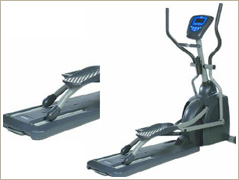 |
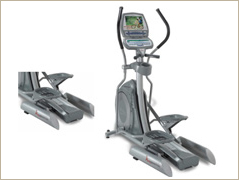 |
Figure 11 Rollers and Tracks
TrimLine E300 |
Figure 12 Hidden Tracks
FreeMotion FMEL4505P |
In addition to rollers and tracks, some elliptical cross trainers resort to extendable tracks to achieve the function of slider, achieving space economy and better degree of constraint.
Figure 15 Extendable Tracks
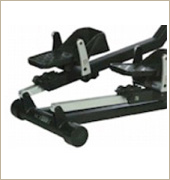 |
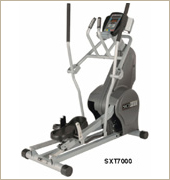 |
| SCIFIT SXT7999 |
|
However, cranks and sliders are not the only mechanical structures for adjusting slanting angles of elliptical routes. Those with crank-rocker structure can also achieve the similar function by simply adjusting the position of fixed pivot or changing the length of the rocker.
Figure 16 Models with Slant-Adjustable Elliptical Routes
 |
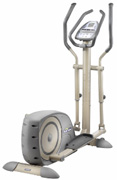 |
| |
Tunturi C60 |
In addition to adjustment of slant angles, the adjustment of the major axis of ellipse is also manufacturers' main concern. Purpose for adjusting the major axis of ellipse is to meet needs for different human sizes. As stride length is usually related to height, distance provided by the device must make proper adjustments according to different heights, so that users can maintain gaits close to natural proceeding and in the most comfortable manner. Meanwhile, stride length of humans when walking or running is also associated to proceeding speed, so the device should also make proper adjustments to provide more suitable distance according to different pedaling speed. Usually, devices achieve adjustment of stride length via linkage length or adjustment in lever ratio.
| |
 |
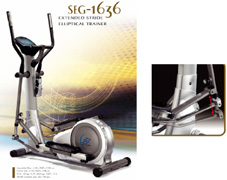 |
| |
CHC Elliptical Cross Trainer with adjustable stride length |
Figure 17 Products with Adjustable Stride Length |
In order to augment energy consumption when pedaling or to change lower-limb muscles in use when exercising, in addition to adjusting slant angles of elliptical routes to produce slope-climbing effect, enhancement of stride length or increase of the minor axis of the ellipse can also produce a similar effect but such kinds of products are quite rare on the market.
Although elliptical cross trainers produce much less impact on lower limbs in comparison with treadmills, some products make further improvement in this aspect by enhancing shock-absorbing function via installation of cushions under pedals or the use of flexible linkage.
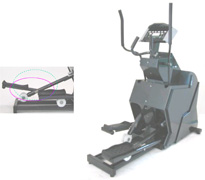 |
 |
| CHC Elliptical Cross Trainer with adjustable Route |
Figure 19 Products with Cushion
Pro Form 750 |
For elliptical cross trainers, it is not easy to achieve the foldable function, as they are comprised of linkages and thus are restricted by synchronized
movements of linkages. Therefore, it is very rare for the product to be furnished with the function.
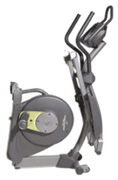 |
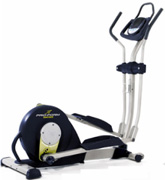 |
Figure 20 Foldable Products
Pro Form 900 space saver |
In order to boost added value, some manufacturers have also rolled out composite products, which are not pure elliptical cross trainers but products
capable of doing other forms of exercises.
| Up to now, elliptical cross trainers have become one of the most popular sporting devices, attracting the engagement of many manufacturers and enriching varieties of the product for choice by consumers. However, despite the establishment of a solid foundation by years-long efforts of manufactures, elliptical cross trainers have run into a bottleneck in structural innovation, leading to increasing complication in its structural design, which is unfavorable to cost and maintenance, with its acceptability among consumers remaining to be seen. |
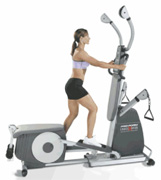
Pro Form cross_over |
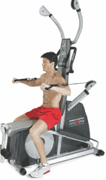 |
| |
|
|
|